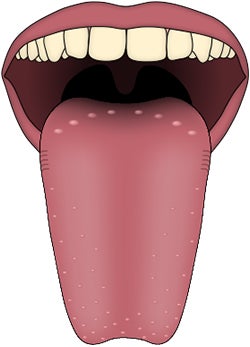show/hide words to know
Can You Lose Your Sense of Taste?

Because your sense of smell affects taste, having a cold can alter your ability to taste. Image by the CDC.
Even the most delicious food is left unappreciated if there is a problem with the taste system. Nearly everyone can relate to the reduced sense of taste that occurs during a cold or flu. Congestion in the nasal cavity often clogs the special pathway that connects the mouth to the nose. That pathway is important for the full flavor experience.
Temporary taste disturbances, termed disgeusia, that result from illness or injury generally improve once you get better. Sometimes, however, the cause for a taste disturbance is not so easy to identify or fix. When a person has a reduced sense of taste, there is often a problem with other senses as well, especially olfaction, since the two senses interact a lot.

Taste tests can be used to learn what part of your tongue senses which tastes. Doctors also use taste tests to find out if you can taste solutions at normal concentrations.
Diagnosis of disgeusia, or the more extreme ageusia, which is the complete lack of taste, is done by a special doctor. Otolaryngologists specialize in the ear, nose, throat, head and neck. The doctor will typically perform gustatory testing, in which different solutions – sweet, sour, salty, and bitter – are given to the patient. The lowest concentration of these tastes that someone can identify, called the taste threshold, is determined, and compared to the average level.
Taste disturbances can result from any condition that alters the functioning of taste receptors, the taste-carrying nerves, or the regions of the brain that process the taste signal.
- Saliva is crucial for keeping taste buds moist and to ensure taste receptors work well. Chemotherapy treatment can cause damage to tissue in the mouth, especially the tissue that produces saliva, so chemo is often accompanied by taste disturbance. Similarly, dry mouth syndrome, in which saliva production is lowered, can cause disturbed taste. To figure out if saliva production is the underlying cause of taste disturbance, saliva can be analyzed, and drugs that increase saliva production can be prescribed.
-
Taste receptors also require certain chemicals that are vital for their functioning. Zinc is an essential element included in our diet that is critical for the repair and protection of taste buds. A zinc deficiency is another cause of taste disturbance, which can be easily fixed by taking a zinc dietary supplement.

Taste can be affected if there are problems with the receptors on the cells of your tongue, with the nerves that send taste signals to the brain, or in the brain itself. Image by Jonas Töle.
- Injury to one of the two major nerves that carry the taste signal could be responsible for a change in taste. Lesions or wounds in the areas of the brain responsible for processing this signal may also be the cause of a lack of taste. Imaging of the nervous tissue by an MRI (magnetic resonance imaging) can help to determine if this is the case.
As people age, the sense of taste, along with most of the other senses, begins to get worse. The average person is born with about 9,000 taste buds, which normally replace themselves every 1-2 weeks. This replacement process, however, appears to slow as we age. In addition to the aging of the olfactory system, and the increased use of medications among older people that can interfere with taste, this means that taste fades with age. Altered taste becomes noticeable around age 40, and often happens earlier in women than in men. While we can work to improve the flavor experience by seeking out spicy, bold flavors with enjoyable textures, this is just part of the normal aging process.
Additional images via Wikimedia Commons. Millet dish by Jennifer from Vancouver.
View Citation

What would life be like if you lost your sense of taste?
Be Part of
Ask A Biologist
By volunteering, or simply sending us feedback on the site. Scientists, teachers, writers, illustrators, and translators are all important to the program. If you are interested in helping with the website we have a Volunteers page to get the process started.







